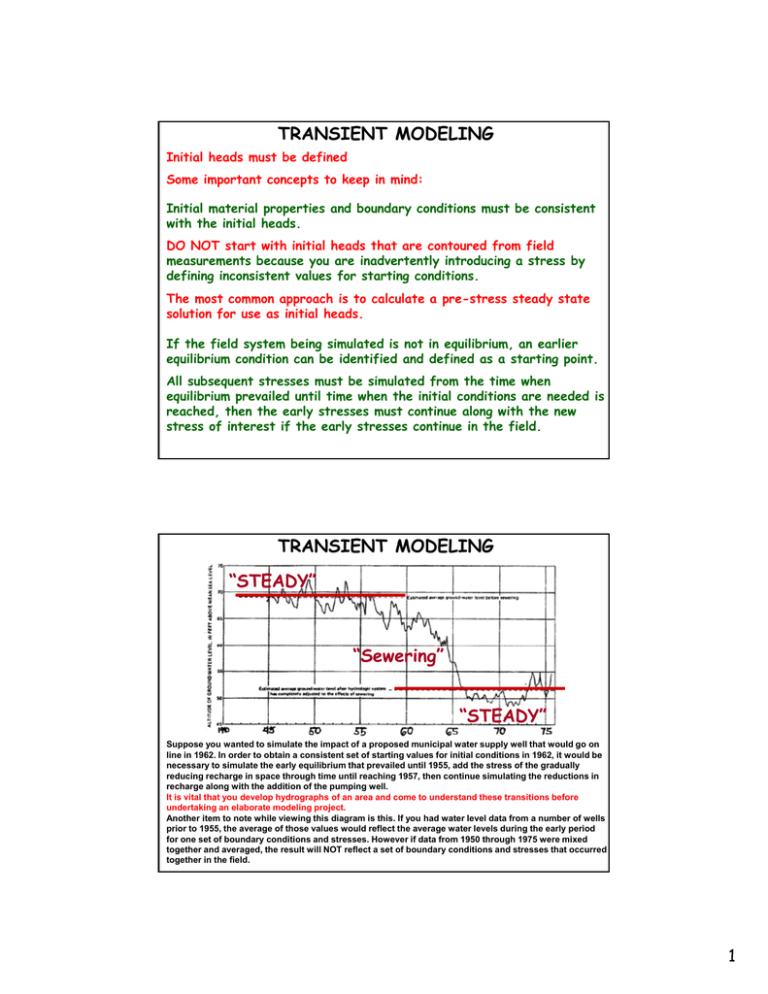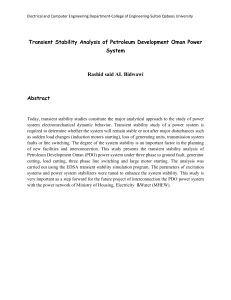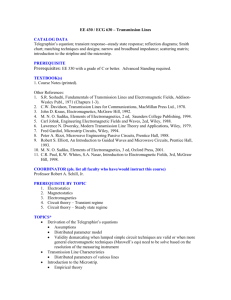TRANSIENT MODELING
advertisement

TRANSIENT MODELING Initial heads must be defined Some important concepts to keep in mind: Initial material properties and boundary conditions must be consistent with the initial heads. DO NOT start with initial heads that are contoured from field measurements because you are inadvertently introducing a stress by defining inconsistent values for starting conditions. The most common approach is to calculate a pre-stress steady state solution for use as initial heads. If the field system being simulated is not in equilibrium equilibrium, an earlier equilibrium condition can be identified and defined as a starting point. All subsequent stresses must be simulated from the time when equilibrium prevailed until time when the initial conditions are needed is reached, then the early stresses must continue along with the new stress of interest if the early stresses continue in the field. TRANSIENT MODELING “STEADY” “Sewering” “STEADY” Suppose you wanted to simulate the impact of a proposed municipal water supply well that would go on g values for initial conditions in 1962,, it would be line in 1962. In order to obtain a consistent set of starting necessary to simulate the early equilibrium that prevailed until 1955, add the stress of the gradually reducing recharge in space through time until reaching 1957, then continue simulating the reductions in recharge along with the addition of the pumping well. It is vital that you develop hydrographs of an area and come to understand these transitions before undertaking an elaborate modeling project. Another item to note while viewing this diagram is this. If you had water level data from a number of wells prior to 1955, the average of those values would reflect the average water levels during the early period for one set of boundary conditions and stresses. However if data from 1950 through 1975 were mixed together and averaged, the result will NOT reflect a set of boundary conditions and stresses that occurred together in the field. 1 What can we do if we cannot use a steady state initial condition because our problem is dependent on a short term response during a particular time of year? In this case there may be a quasi-cyclic equilibrium in the area, that is a general repetition of conditions that occur year after year and we may attempt to represent that situation, then start our stress at the appropriate point in the cycle. Draw diagrams of the variations and the timing of your stress and coordinate this with a diagram of model stress periods and time steps to help yourself get everything timed correctly in your model. model What if we do not have sufficient data to establish an acceptable steady initial condition to commence our cyclic equilibrium? In this case, we may be able to start with a rather arbitrary initial condition but simulate the cycle long enough such that we simulate the same values at the same times in subsequent cycles. It may y be that there is enough g information in your y transient data to estimate initial conditions. This can be judged by evaluating the sensitivity of initial conditions to the available data and the correlation of parameters defining those conditions to other parameters that are estimated. Finally, it is useful to note that the further in time the simulation is from the initial conditions the less influence those initial conditions have on the simulated values. TIME STEPS time steps are the temporal equivalent of grid cells, they should be small when stresses change and increase in length to a constant, convenient size until the stresses change STRESS PERIODS stress periods are groups of time steps during which the stresses do not change 2 Create a transient flow model from the steady state model TRANSIENT MODELING REQUIRES: TIME DISCRETIZATION INITIAL CONDITIONS STORAGE PARAMETERS ONE or more S STRESSES RESSES Create a folder for the transient model Copy in the steady state prediction modflow files Perhaps rename to indicate they are transient quick option for renaming in a command window e.g. copy ep* eptr* My Transient Files for the Class Example can be downloaded form the class web page Consider each file in the name & bat files, edit the name if you changed it, and determine if it needs changes in order to conduct a transient simulation 1 2 3 4 5 6 7 8 9 10 3 Transient Parameters SY = 0.25 in the sand 1.1x that in the more permeable lens SY = 1.0 in the reservoirs (4 x Sysand but cell 50% sand) 2.5 1.1 1.1 1.0 1.0 1.0 1.0 1.0 1.0 2.5 Do not use a multiplier for reservoirs if you are going to adjust SY for calibration Ss = 1x10-6 in both layers Make these changes in lpf mlt & pval files Transient Stresses (4 stress periods) 1) simulation starts with a steady state no pumping condition 2) pumping of 3cm3/sec for 5 minutes 3) pumping continues & recharge decreases to 50% for 5 minutes 4) original recharge returns with continued pumping How long does it take to reach a steady state after that? Well in layer 1 row 2 column 5 Make changes in dis (see next slide) oc wel rch mlt riv files I saved all head and budget information for illustrative purposes Note the use of instances for the rch variation Use ob files to print predictions at end of stress periods 2, 3, & 4 4 TRANSIENT MODELING REQUIRES TIME DISCRETIZATION dis – increase to 4 periods, defined at the end of the file At first try 5 steps with a 1.1 multiplier explore mass balance and storage rates then adjust #steps and multiplier later Guess at possible time required to reach SS adjust as needed after seeing results 1 1 1 SS 300 5 1.1 TR 300 5 1.1 TR 3000 30 1 TR oc – print the budget for every step so we can explore for this small model (see oc file in zip file) RUN MODFLOW Check lst file Make sure mass balances are OK at all time steps Make sure that the cell with the well did not go dry Check that the heads are reasonable VERY IMPORTANT TO MAKE SURE THE MODEL MAKES SENSE AND DOES WHAT YOU EXPECTED: Using GWChart View Water Budgets (check modflow, modflow look at rates) View Hydrograph for the well cell Do the graphs make sense? 5




